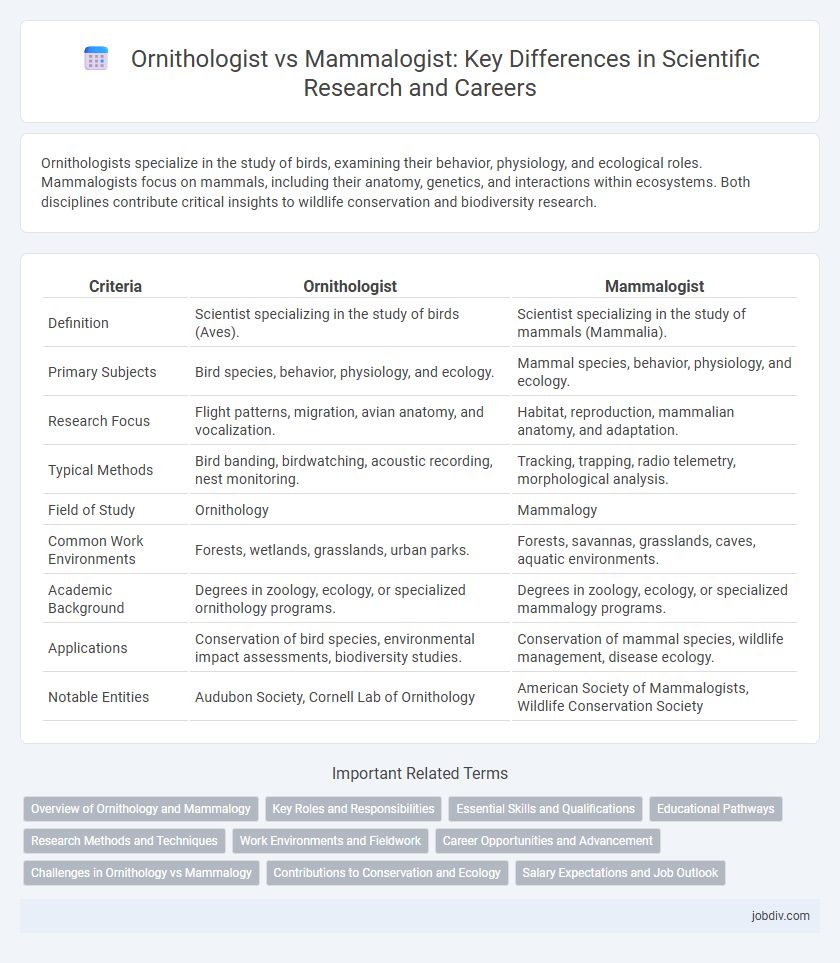Ornithologists specialize in the study of birds, examining their behavior, physiology, and ecological roles. Mammalogists focus on mammals, including their anatomy, genetics, and interactions within ecosystems. Both disciplines contribute critical insights to wildlife conservation and biodiversity research.
Table of Comparison
| Criteria | Ornithologist | Mammalogist |
|---|---|---|
| Definition | Scientist specializing in the study of birds (Aves). | Scientist specializing in the study of mammals (Mammalia). |
| Primary Subjects | Bird species, behavior, physiology, and ecology. | Mammal species, behavior, physiology, and ecology. |
| Research Focus | Flight patterns, migration, avian anatomy, and vocalization. | Habitat, reproduction, mammalian anatomy, and adaptation. |
| Typical Methods | Bird banding, birdwatching, acoustic recording, nest monitoring. | Tracking, trapping, radio telemetry, morphological analysis. |
| Field of Study | Ornithology | Mammalogy |
| Common Work Environments | Forests, wetlands, grasslands, urban parks. | Forests, savannas, grasslands, caves, aquatic environments. |
| Academic Background | Degrees in zoology, ecology, or specialized ornithology programs. | Degrees in zoology, ecology, or specialized mammalogy programs. |
| Applications | Conservation of bird species, environmental impact assessments, biodiversity studies. | Conservation of mammal species, wildlife management, disease ecology. |
| Notable Entities | Audubon Society, Cornell Lab of Ornithology | American Society of Mammalogists, Wildlife Conservation Society |
Overview of Ornithology and Mammalogy
Ornithology is the scientific study of birds, encompassing their physiology, behavior, ecology, and conservation. Mammalogy focuses on mammals, investigating species diversity, evolutionary biology, and habitat requirements. Both disciplines contribute vital knowledge to understanding vertebrate biology and promoting biodiversity preservation.
Key Roles and Responsibilities
Ornithologists specialize in studying birds, focusing on avian behavior, migration patterns, and conservation efforts to protect bird species and their habitats. Mammalogists concentrate on mammals, analyzing their physiology, genetics, and ecological impacts to advance wildlife management and biodiversity preservation. Both roles require field research, data collection, and collaboration with conservation organizations to inform environmental policies and scientific understanding.
Essential Skills and Qualifications
Ornithologists require expertise in avian biology, field observation techniques, and proficiency in bird banding and identification, often holding degrees in environmental science or zoology with specialized training in ornithology. Mammalogists must possess strong skills in mammal anatomy, ecological data analysis, and tracking methods, typically earning degrees in biology or ecology with certifications in mammalogy or wildlife management. Both professionals benefit from experience in statistical analysis, GIS mapping, and a solid foundation in scientific research methodologies to conduct effective field studies and conservation efforts.
Educational Pathways
Ornithologists typically pursue degrees in biology, zoology, or ecology with specialized coursework in avian biology and field research techniques, often advancing to a master's or Ph.D. focused on bird behavior, physiology, or conservation. Mammalogists follow a similar academic trajectory but emphasize mammalian anatomy, physiology, and ecology, engaging in studies related to mammal species diversity, habitat management, and population dynamics. Both fields require strong foundations in genetics, taxonomy, and environmental science, with practical experience gained through internships, research projects, and wildlife surveys.
Research Methods and Techniques
Ornithologists employ field observation, mist-netting, and bioacoustic monitoring to study avian species' behavior, migration, and ecology, utilizing tools like bird banding and telemetry for data collection. Mammalogists utilize live trapping, tracking collars, and camera traps to investigate mammalian population dynamics, habitat use, and physiology, often incorporating genetic analysis and radio telemetry to enhance their research accuracy. Both disciplines rely heavily on statistical models and ecological sampling methods tailored to their target organisms to generate reliable scientific data.
Work Environments and Fieldwork
Ornithologists primarily conduct research in diverse environments such as wetlands, forests, and coastal areas to study bird species, often utilizing binoculars and audio recording devices for field observations. Mammalogists typically work in a variety of habitats including grasslands, deserts, and forests, focusing on animal behavior and physiology by capturing data through tagging and tracking techniques. Both specialists frequently collaborate with research institutions, wildlife reserves, and universities, although their fieldwork methods and ecological focus differ significantly.
Career Opportunities and Advancement
Ornithologists specializing in avian biology often find career opportunities in academic research, wildlife conservation, and environmental consulting, with advancement linked to publishing studies and securing grants. Mammalogists, focusing on mammals' behavior and ecology, have roles in zoological institutions, veterinary research, and habitat restoration projects, where promotion depends on field experience and interdisciplinary collaboration. Both careers benefit from advanced degrees and involvement in professional organizations to expand networking and leadership prospects.
Challenges in Ornithology vs Mammalogy
Ornithologists face challenges such as tracking migratory patterns and studying avian vocalizations in diverse habitats, which require specialized equipment like radar and bioacoustics tools. Mammalogists encounter difficulties in monitoring elusive nocturnal behavior and understanding complex social structures of mammals, often relying on camera traps and radio collars for data collection. Both fields demand adaptation to environmental variables and technological advancements to accurately gather and interpret behavioral and ecological information.
Contributions to Conservation and Ecology
Ornithologists contribute to conservation by studying bird migration patterns, habitat requirements, and the impacts of climate change on avian populations, aiding in habitat preservation and species recovery programs. Mammalogists investigate mammal behavior, population dynamics, and ecosystem roles, providing critical data for managing endangered species and maintaining biodiversity. Both disciplines enhance ecological understanding and inform conservation policies to protect wildlife and ecosystems globally.
Salary Expectations and Job Outlook
Ornithologists typically earn an average salary ranging from $50,000 to $80,000 annually, with job growth projected at around 5% through 2030 due to conservation efforts and environmental research. Mammalogists can expect salaries between $55,000 and $85,000 per year, driven by increasing demand in wildlife management and ecological studies, with a slightly higher job outlook growth rate near 7%. Both fields offer specialized roles in research and academia, but mammalogy shows broader employment opportunities in diverse ecosystems and public health sectors.
Ornithologist vs Mammalogist Infographic

 jobdiv.com
jobdiv.com